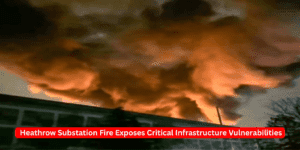By Rakibul Hasan | 21.03.2025
London’s Heathrow Airport, one of the world’s busiest travel hubs, ground to a halt on Friday after a devastating fire at a nearby electrical substation left thousands stranded, homes powerless, and experts questioning the resilience of critical infrastructure. Here’s a breakdown of what went wrong, why backup systems failed, and what this means for global infrastructure standards.

London’s Heathrow Airport, one of the world’s busiest travel hubs, ground to a halt on Friday after a devastating fire at a nearby electrical substation left thousands stranded, homes powerless, and experts questioning the resilience of critical infrastructure. Here’s a breakdown of what went wrong, why backup systems failed, and what this means for global infrastructure standards.

The Incident: Chaos Unleashed
-
What Happened: A fire erupted at the North Hyde substation in Hayes, West London, just before midnight on Thursday. Firefighters contained the blaze by 6:28 a.m. Friday, but not before it triggered a cascading power failure.
-
Impact:
-
Heathrow Shutdown: 1,300+ flights canceled, passengers urged not to travel.
-
Homes Affected: 150+ residents evacuated; thousands in West London lost power.
-
Investigation: Counter-terrorism police are probing potential foul play.
-


Why Did Backup Systems Fail?
Heathrow, which consumes as much energy as a small city, relies on multiple power sources, including a biomass plant and diesel generators. Yet, the outage revealed alarming gaps:
-
Single Point of Failure: The North Hyde substation was the sole link to Heathrow’s local grid. When it failed, backup generators were inexplicably “knocked out,” per Energy Secretary Ed Miliband.
-
Redundancy Shortfalls: Experts note that data centers—with comparable power needs—use dual grid connections, batteries, and generators. Heathrow’s setup lacked this layered resilience.
-
National Grid Flaws: A Heathrow source blamed the grid, emphasizing that homes and the airport shared the same vulnerable infrastructure.


Willie Walsh (International Air Transport Association):
“Critical infrastructure of this importance shouldn’t hinge on a single power source. This is a glaring planning failure.”
Expert Warnings: A Wake-Up Call
-
Phil Hewitt (Montel Group): Highlighted Heathrow’s reliance on one substation as “deeply worrying” for global infrastructure.
-
Robin Potter (Chatham House): Noted Heathrow and Gatwick are the UK’s only airports with regulated resilience standards—yet gaps remain.
Government Accountability :
In 2023, the National Infrastructure Commission urged the UK government to enforce resilience standards for energy, transport, and telecoms by 2025. Despite detailed 2023 proposals, progress stalls.
Key Questions:
-
Why weren’t 2023 recommendations prioritized?
-
How can nations like the US avoid similar vulnerabilities?
When Will Power Return?
-
National Grid: Optimistically estimates restoration “in hours,” but Heathrow warns of “significant disruption for days.”
-
Passenger Advisory: Avoid the airport until further notice.
Global Implications: Lessons for the US
Heathrow’s crisis underscores universal risks:
-
Infrastructure Aging: Many US airports and grids rely on outdated systems.
-
Regulatory Gaps: Without enforced standards, critical hubs remain exposed.
-
Climate & Security Threats: Rising risks of extreme weather and sabotage demand robust redundancy.
Key Takeaways:
-
Redundancy is Non-Negotiable: Critical infrastructure needs multiple fail-safes.
-
Government Action: Policymakers must prioritize resilience mandates.
-
Public Awareness: Voters should demand infrastructure upgrades.
Subscribe to Us For More Updates and News







